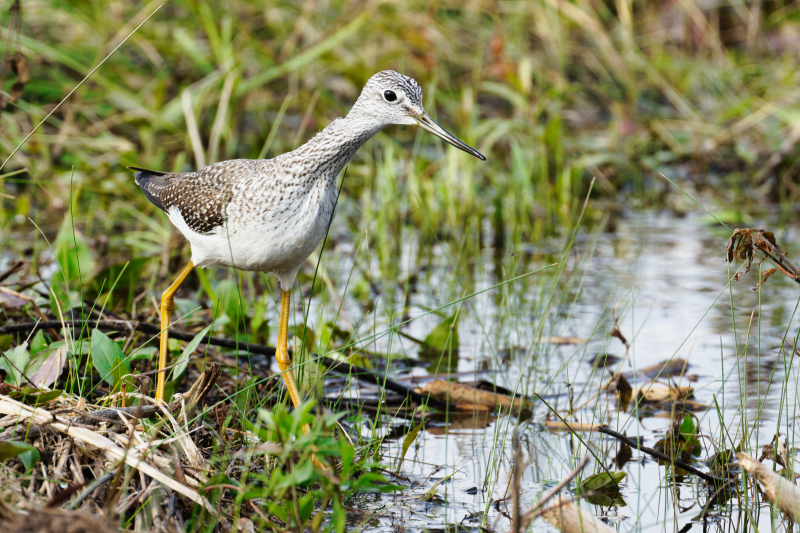In my last post, I shared images of the elusive Wilson’s Snipe that I was fortunate to spot hiding among the weeds. Today, I want to focus on another wading bird species I photographed that day, the Greater Yellowlegs.

Wildlife Notes About Greater Yellowlegs
As mentioned in my last blog post, I first spotted several Greater Yellowlegs wading in the marshy waters. As I slowly rolled down my window to photograph them from inside my truck, a passing car temporarily frightened the Yellowlegs away.
With the Yellowlegs taking flight, I then noticed a few Wilson’s Snipes hiding among the reeds nearby. I captured some nice images of these shorebirds before the Greater Yellowlegs returned shortly after. You can read more about that encounter in my post A Close Encounter with Well-Hidden Wilson’s Snipes.

Greater Yellowlegs are nicknamed “marshpipers” for their preference of wading in deeper water compared to other sandpipers. They have a larger and heftier build than their lookalike cousin, the Lesser Yellowlegs. We see them mostly during migration as they travel between their breeding grounds in Canada and winter spots across the southern U.S.
Their bright yellow legs, robust bill, and measured gait give them a refined presence whether solo or in small flocks. They tend to be wary and often give alarm calls when threats are near. Compared to Lesser Yellowlegs, they favor more open wetlands and larger mudflats. Their diet includes insects, insect larvae, small fish, crustaceans, snails, and other aquatic creatures.
Photography Notes
I photographed these Greater Yellowlegs from my truck along the auto tour road at Sequoyah National Wildlife Refuge in Oklahoma. Shooting from my vehicle allows me to get closer to wary shorebirds without spooking them. The morning light was soft and even, which helped bring out the detail in the bird’s plumage and highlighted those distinctive yellow legs.
I was using my Canon EOS R7 paired with the Canon EF 100-400mm f/4.5-5.6L IS II USM lens. For the first image, my settings were ISO 640, aperture f/7.1, and shutter speed 1/800 sec at 400mm. I had the lens resting on a beanbag draped over the window frame for stability. The shallow depth of field kept the bird sharp while softly blurring the foreground and background vegetation.
The second image captured a beautiful reflection of the bird in the calm water. I positioned myself to include the reflection while keeping the bird in focus. The overcast sky reduced harsh shadows and gave the scene a moody, natural feel.
If you’re interested in more tips on photographing wildlife from your vehicle, check out my post Photographing Wildlife from Your Vehicle: Tips and Tricks. For more images from Sequoyah, visit my post Exploring Sequoyah National Wildlife Refuge Through My Lens.
